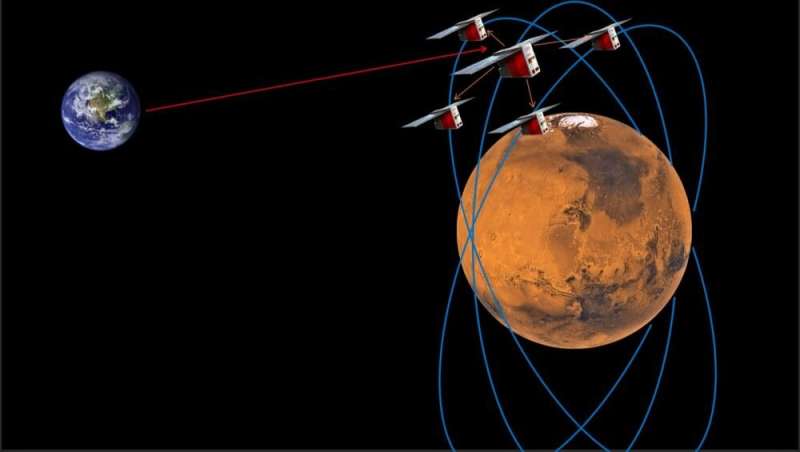This is a commodity that any future Mars explorers will need to tap into for survival and other operations. All of these reasons make the polar regions a prime target for future rovers.
Today, orbiters around Mars do the heavy lifting of communications between Earth and the red planet. But future exploration requires more flexible communications systems, particularly if we're going to study the polar regions. So, imagine this scenario: NASA or another agency wants to send a fleet of rovers to Mars's polar caps. Distance complicates communications from the ground to the rovers for their every move. Light-travel times of many minutes could make it very hard to navigate in "real-time" situations. The solution is to deploy satellite constellations that can "see" the polar regions and help the rovers navigate more accurately.
Small satellites to the rescue
A team of engineers led by Ph.D. student Serena Molli at the Department of Mechanical and Aerospace Engineering at the Sapienza University of Rome did a concept study of small satellite (smallsat) constellations at Mars. Their objective is to design one that is almost completely autonomous and can handle the relative and absolute positioning of its nodes around the planet. The constellation should support navigation for other probes, such as objects in the Entry, Descent, and Landing (EDL) phase, as well as landers, rovers, or orbiters. Nodes would communicate with each other via an inter-satellite link (ISL) and with the rovers and other installations on the surface.
In an upcoming paper in Acta Astronautica, Molli and the team outline models for two such constellations. They focus on systems that don't need constant updates from Earth. Each uses five satellites to communicate with each other and the surface. Depending on their orbital configuration, they could give nearly constant coverage of the polar regions.
"We achieved excellent performance with this autonomous navigation system without the need for AI programming," Molli explained. "The onboard software relies on dedicated orbit determination theory and algorithms, adapted to face the challenge of the novel autonomous navigation system. However, the onboard orbit determination software may benefit from updates. The system allows for those. What we need is a sufficiently powerful onboard computer and periodic contacts to Earth, both for health checks of the system, improved orbit determination, and, if necessary, software upgrades."

Navigating Mars
The team's proposed navigation systems are based on smallsats currently in design at the Italian aerospace engineering group Argotec. They're working on a proposed microsatellite-based "internet of the moon" system called ANDROMEDA. The systems Molli's team propose have the required ISL technology that fosters communication between satellite nodes. This was used previously for terrestrial and planetary geodesy, most notably with the GRACE and GRAIL missions.
Applying it to Mars requires a lot of data about the planet in order to make the system work efficiently. "In our work, we exploit the previous knowledge of the Martian gravitational field from missions such as MRO (Mars Reconnaissance Orbiter) and MGS (Mars Global Surveyor)," said Molli. "This allows the spacecraft of the constellation to determine its position autonomously or with a sporadic link with Earth, depending on the altitude of the orbits and consequently on the effects of the gravity gradients on the spacecraft dynamic."
Small satellites at other worlds
The team points out that these smallsat constellations come with low development and launch costs and short development times. They also offer flexibility in mission implementation. That's because multiple systems can be launched simultaneously with dedicated launches or as secondary payloads of larger missions. If this all pans out at Mars, it's possible that similar satellite systems could be used on other worlds in the solar system. However, those come with great unknowns.
"There are several challenges to deploying this navigation system on other planets and moons," said Molli. "The environmental conditions are quite different: radiation fields, a different thermal environment, etc. Therefore, the hardware must be adapted to cope with the moon's environment. In addition, the knowledge of the gravity field and rotational state of those bodies may not be known at the required levels to perform precise positioning."
The first test of such a system will begin at Mars as spacecraft teams plan polar missions. So, the development of small satellite constellations is crucial. Not only will they help in the exploration of Mars, but eventually could pave the way for similar constellations around worlds beyond the red planet.
Related research has also been published in The Planetary Science Journal.
More information: S. Molli et al, Design and performance of a Martian autonomous navigation system based on a smallsat constellation, Acta Astronautica (2022). DOI: 10.1016/j.actaastro.2022.11.041
Patricio Becerra et al, Past, Present, and Future of Mars Polar Science: Outcomes and Outlook from the 7th International Conference on Mars Polar Science and Exploration, The Planetary Science Journal (2021). DOI: 10.3847/PSJ/ac19a5
Journal information:The Planetary Science Journal, Acta Astronautica
Provided by Universe Today



